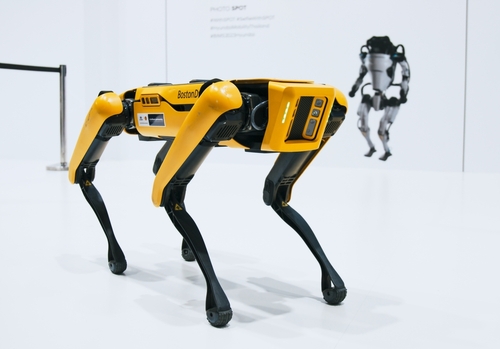Editor’s note: The Global Security Exchange (GSX), presented by ASIS International, is an annual gathering of security professionals worldwide. ESFM Vice President of Security Solutions Russ Collett recently attended GSX 2023 in Dallas and wrote his takeaways on how key trends apply to facilities management.
The world is getting smaller, technology is getting smarter, and facilities managers are juggling more than ever to try and keep up.

The one-two punch of both physical and digital threats makes operational vigilance critical. Whether FMs self-perform or outsource security, working hand-in-hand with security partners is a must. Building occupant safety and security are everyone’s responsibility.
As digital convergence accelerates and society adapts to new technology, facilities managers should keep the following security trends top of mind as they look to create a safer future workplace experience.
Prevention: The Next Advancement
Over the years, there has been a positive shift in security operations becoming more proactive and less reactive. The next step is going from being proactive to preventative. That’s where the conversation is advancing today in Enterprise Security Risk Management (ESRM).
Rather than waiting for a disruptive event, such as a cyberthreat, teams need to break down departmental walls to prevent them. Facilities managers should work in sync with information technology, operational technology, and physical security leaders to identify possible vulnerabilities, such as building automation systems, and ensure they’re properly secured.
Security technology provides a wealth of data to allow facilities managers and security professionals to equip business leaders with up-to-date information. Together, these parties should create proactive response plans and implement appropriate policies and procedures that manage current threats. Response and recovery plans should be created, and table-top drills, data backup, and recovery exercises should happen with regularity.
In the physical security world, prevention goes beyond securing typical points of entry. Think about who has access to electrical server rooms, for instance. If they’re not locked down and monitored via alarms and cameras, there’s a point of vulnerability that should be addressed.
The entire facility should be part of preventative security efforts. FMs can arm all occupants with information—training them in situational awareness and actionable intelligence—so that they can be engaged in the process.
For example, facilities can sync access control with mobile technology to increase understanding of the environment in the building. Occupants who opt-in can share their locations, so the security team knows their whereabouts during a crisis or can send them instant alerts. What’s more, employees and occupants can immediately report threats from their phones.
There are also technology applications where occupants can access cameras so, for instance, they could check that the route to their car is clear before walking to the parking deck and not require a security escort.
Embracing AI
Artificial intelligence (AI) isn’t coming. It’s here. The question is whether one will embrace and utilize it effectively. In security, AI is a welcome innovation as it puts more distance between potential threats and both security officers and the people and property they protect.
Leveraging AI in security technology allows teams to work smarter and safer. With AI, cameras and autonomous sensors can detect suspicious behaviors, such as people loitering or cars approaching after hours, and automatically alert, engage, and deter with an audible message or live voice interaction.
In contrast, this same technology can be used to send welcome messages and important updates to engage occupants as they enter a building complex and be used for daily activity reporting and security awareness education.
Security should be viewed as an extension of hospitality, and technological touchpoints are no exception. Whether it’s a uniformed officer saying “good morning” in the lobby, or a flashing message on a parking lot device reading “drive safe” as employees walk to their cars in the evening, these touchpoints send reassuring messages that the safety of their employees and guests is top of mind.
Robots on Patrol
The security robots market reached $31.7 billion in 2022 and is projected to reach $71.8 billion by 2027, according to research firm MarketsandMarkets. That’s a compound annual growth rate of 17.8%.
GSX 2023 took note and showcased an increasing number of security robotics offerings on the market today, including the four-legged autonomous kind. Robotic dogs can cover a lot of ground as patrol units along fence lines and challenging terrain for large corporate campuses.
Powered by AI, their applications go beyond sensing and reporting potential threats. They can be programmed to identify, engage, and deter threats. They can detect safety risks such as cuts in a fence line or environmental concerns without putting people in danger.
Drones can act as a patrol enhancer. (They can also be used for facility services like window cleaning.) However, human operators are needed to maneuver drones. Robotic canines can make their rounds autonomously.
All of these futuristic gadgets are nice to have, but it’s important to leverage technology effectively and find functional and cost-effective solutions that are right for the problems they’re intended to address.
When applied properly, these tools help maintain a preventative approach to security that further distances potential risks from the facility and its occupants.
The Future Is Inclusive
Not all advancements are technological. Diversity, equity, and inclusion (DEI) conversations continue to push industries into action, and security is no exception.
Whether it’s security, facilities management, or another facet of operations, it’s important to intentionally include diverse talent, voices, and perspectives into the organization at all levels. GSX 2023 leaned into the conversation, welcoming diverse security leaders and minority- and women-owned businesses from around the world. It was an encouraging picture of inclusion: approximately 16,000 people representing 95 nations, sharing a common goal—making the world a safer and more welcoming place for all.

Russ Collett is the vice president of security solutions at ESFM, the corporate integrated facilities management division of Compass Group USA. He has over three decades of security experience, including 25 years with the United States Secret Service as a special agent. Collett serves on the Illinois Security Professionals Association’s board of directors and is an active member of ASIS International and the United States Secret Service Association.







